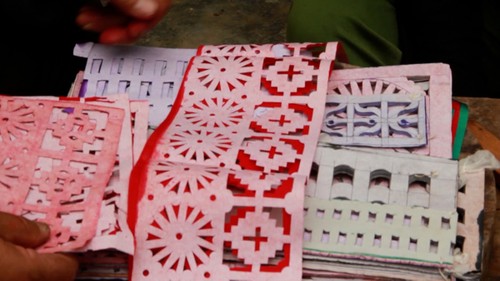 Paper-cut pictures of Nung Dinh in Muong Khuong district, Lao Cai province (VOV) Paper-cut pictures of Nung Dinh in Muong Khuong district, Lao Cai province (VOV) |
Paper-cut pictures have been an important part of the religious life of generations of the Nung Din people in Muong Khuong district.
The pictures are made whenever someone in the community dies. These are offerings to the deceased to show the filial piety of the children and grandchildren for their parents or grandparents when they go to the afterlife.
The Nung Din believe that when a person dies, their soul leaves their body and exists in a supernatural world but can still influence the living. Souls can return to earth to visit their family and bless their relatives with prosperity, good health, and peace.
Van Van Chien is one of the best paper-cut artisans in Nấm Oọc hamlet. He says most of the men there can make paper-cut picture.
“I love this art very much. I make paper cut pictures for all funerals in the hamlet. Our ancestors handed down the craft to us and we are trying to preserve it.”
Paper-cut pictures are indispensable at a Nung Din funeral. When there is a death, artisans are invited to come make paper-cut pictures for the deceased to take to the afterlife. These are images of houses, utensils, money, and tools.
 Nung Din men are making paper-cut pictures. (Photo: VOV) Nung Din men are making paper-cut pictures. (Photo: VOV) |
The artisans chisel various images and patterns on sheaves of paper. Because the motifs and patterns are very small and close together, the chisel blades must be very sharp and the movements must be precise and skillful. Depending on the pattern, the artisan will use scissors, knives, awls, chisels, or hammers to create sharp, delicate lines. A paper-cut picture often has many layers and colors.
Nung Chan Phin, former Deputy Director of the Lao Cai provincial Department of Culture, Sports, and Tourism, said: “The artisan must chisel the paper-cut pictures according to customs and norms. If the items are incorrectly made, they cannot be used.”
Paper-cut picture classes have been organized to preserve this art. Lù Phìn Hòa of Văng Leng hamlet, said: “I teach 5 or 6 classes for young people and one class for people over 30.”
The paper-cut pictures of the Nung Din teach people about their roots and life values.